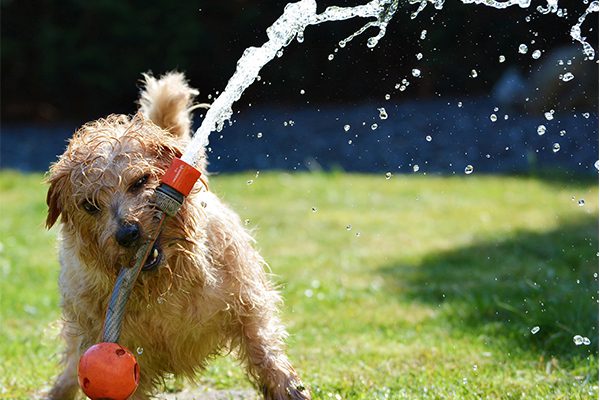Tips To Protect Your Pets From The Hot Summer Sun

The dog days of summer will be upon us soon, and that means it’s time to brush up on our safety tips to keep your furry family member safe throughout the season. Every year, emergency rooms across the country receive many cases in which dogs and cats are suffering from heat stroke or burned paws, among other things. We hope that the following tips will help you and your pet enjoy a wonderful, safe summer.
5 Summer Safety Tips to Protect Your Dog from the Heat:
Use Pet-Friendly Sunscreen for Dogs and Cats
Skin cancer affects pets just as it does humans. The UV rays from prolonged sun exposure can cause skin damage and sunburn and increase the risks of skin cancer. Owners who live in particularly sunny areas or have pets that love to sunbathe frequently should apply pet-friendly sunscreen on their pets. Do not apply sunscreen made for humans on animals, as it can contain ingredients that are toxic to them. The risks of skin cancer are higher in pets with white or light-colored coats.
Common types of skin cancer include melanoma, squamous cell carcinoma, and mast cell tumors. Signs of skin cancer can range from lumps and bumps on your pet’s bodies to small round bumps around the mouth, nose, toes, or footpads. These small bumps can be black, brown, or pink. Any new lump and bump (no matter how small) should be observed and examined by your veterinarian. Any bump that changes shape or grows needs to be seen immediately. We highly recommend these bumps be biopsied or aspirated to test for cancer.
For more information on the diagnosing and staging process of cancer, please read our “Pet Cancer Diagnosis: What to Expect” post.
Recognize Signs of Heat Stroke in Your Pet
Both dogs and cats can get heat stroke. This is a serious condition caused by the body being overheated. Heat stroke can cause damage to the body’s organs and brain along with complications such as blood clotting, kidney failure, seizures, muscle tremors, cardiopulmonary arrest, and others. Heat stroke is a condition in which the body can no longer accommodate the external heat and therefore begins to shut down. In pets, heat stroke can be deadly and requires treatment immediately. In many cases, pets that have heat stroke are often hospitalized for stabilization.
Dogs have a normal body temperature between 101– 102.5° F. When their temperature rises above 103° F, they should be cooled down. Here are some of the signs and symptoms that your pet is overheated:
- Heavy, rapid panting
- Bright red tongue
- Excessive drooling with thick, sticky saliva
- Pale or red gums
- Fast or irregular heart beat
- Frequent pausing in activity to lie down
- Weakness
- Dizziness
- Diarrhea
- Vomiting
- Seizures
Even after you have cooled your pet down, it is important that a veterinarian promptly checks them for complications or damages.
Avoid Walking Your Dog During the Day
When the temperature is high outside, it’s best to avoid walking your dog. The primary way dogs cool down is by panting. The secondary way is by being in an environment cooler than he or she is (e.g., in front of a fan, hosed down with water, sitting on top of cool tiles). The problem with walking or exercising during the hottest time of the day is the risk that you may not reach home fast enough to cool your dog down if you see warning signs of heat stroke. During the summer season, consider changing your pet’s walking schedules to earlier in the day or during the evening. If you live in a region that is extremely hot even during these times, consider putting protective shoes on your dog’s feet.
Check the Pavement Before Walking
Before walking your dog, make sure to check the pavement with the “5-second rule.” Place the back of your hand on the pavement. If you cannot hold it for five seconds, it’s too hot to walk your dog.
Leave Your Pet at Home – Not in the Car
Every year, dogs are rushed to the emergency room after being left in a car for too long. In many cases, these animals end up dying due to heat stroke. NEVER leave your pet in the car. It’s not enough to crack the window and park in the shade. Your car can heat up extremely quickly, creating a dangerous/deadly situation. For example, when outside temperatures are 75° F, the inside of your car can climb to 94° F after just 10 minutes. After 30 minutes, the temperature can reach 109° F. The risk of leaving your pets in your car is simply not worth it. Leave your pets at home where they can be comfortable.
We hope that these tips will help keep your pet safe and happy throughout the hot summer days. Please share this article with friends and family to educate them about summer safety for their pets.
